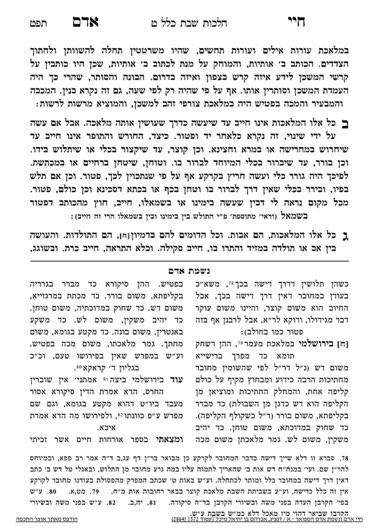We are continuing in siman 2, where the Chayei Adam is discussing melachos performed with a shinui or ki’lachar yad. We learned that the concept of shinui is part of the concept of meleches machsheves. In general, the principle by shinui and ki’lachar yad is that even if one is not chayav mideoraysa, it is still assur miderabanan. Chazal were concerned that the melacha performed with a shinui is similar enough to the melacha that one will confuse it with the regular performance of the melacha. Therefore, Chazal made a gezeira and prohibited it.
When it comes to an issurei derabanan, there are cases where Chazal did not extend their gezeira. One type of case is where it would make sense to be concerned for confusion and to apply the gezeira, but Chazal nevertheless felt a need to create a heter. One example is in losh, creating a mass, where there are certain scenarios which Chazal permit.
The other type of case to which Chazal do not extend their gezeira is where the shinui is significant and therefore the action will not be confused with the issur deoraysa. This can be understood in two ways. Either it is the same as any other shinui, but still different enough to not be confused with the issur deoraysa.
However, the achronim approach it from a different angle, and understand that there can be a shinui which is so significant it no longer has the same tzuras hamelacha, presentation or form of the melacha.
One example comes up with borer. If borer is done by hand, for immediate use, and by separating good from bad, it is considered derech achila and muttar. The achronim understand that the definition of the melacha of borer is separating good from bad for future processing. The Ralbag writes (parshas Yisro) that eating is something we share with animals, and as it does not express the creativity of man, the melacha of borer is not sorting for eating, but sorting for storage. It is specifically future processing which demonstrates melacha, because processing for the future demonstrates creative work, as Rav Hirsch explains (see shiur S255). If so, separating for immediate consumption has no sense of melacha whatsoever, so it is not the melacha prohibited from the Torah. so, borer for immediate use is not considered borer, nor is it similar to borer. Therefore it is not only patur, but even muttar.
Summary
- Melacha done in an abnormal fashion, even if the result looks normal, is patur. This is known as melacha done with a shinui or melacha done ki’lachar yad.
- Patur does not mean muttar, and the action is assur miderabanan.
- Chazal institute issurei derabanan on scenarios which can be confused for the melacha deoraysa.
- At the same time, they will not extend their gezeira to cases where they feel the need to create a heter,
- or where the shinui is significant enough that the action no longer retains the tzuras hamelacha of the issur deoraysa.



